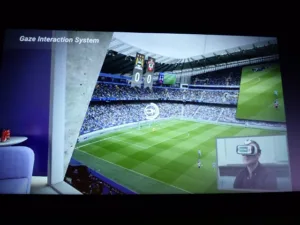The final session of the first day dealt with ‘Emerging Media Technology’ – virtual and augmented reality – in the cinema industry. Simon Gauntlett, CTO of the Digital Television Group, opened the discussion.
Gauntlett cited Pokémon Go as an AR driver, and said that horror and pornography industries love VR. “But is it limited to the geeky and gothy?” he asked. Developing for the format might require a whole new design language.
Richards Nockles is creative director of Sky VR Studios. He agreed with Gauntlett and said that gaming is pushing VR, and made people realise that VR is a completely different way to engage with audiences. “We are not saying that VR will replace traditional content,” he added, but there are no rules in VR production yet, “and that’s exciting.”
Next to speak was Jeremie Lasnier of Livelike VR. His company is developing a way to use VR with friends. Most VR experiences put you in a 360° video, but why bother when there is a clear focal point, he asked? This is especially true for sporting content. There has been a big push to get people to wear VR headsets to watch sports and believe that they are part of the crowd. Livelike, though, thinks that sports are always more fun when watched with friends.
Rather than a 360° experience, Livelike provides viewers with a 180° video and a 3D suite: it looks as if they are sitting in a box in the sports stadium. Users can turn away from the match and look around inside the suite, which is populated with sofas and pictures. There is room here for product placement, too – we spotted a Coke can on a table.
As well as watching the game in front of them, users can look at the floor of the suite to view match statistics (using gaze interaction). Friends can join, as well; users will see an avatar of their friend next to them on the sofa. Another interesting addition was the way in which Livelike used mixed reality. Directly across the stadium from the virtual box is a giant video screen, which is added by Livelike and shows a real-time broadcast of the match. This screen can also be used for adverts in breaks: Lasnier demonstrated the screen showing a Star Wars advert and then a 3D X-Wing fighter racing across the stadium.
Livelike is focused on mobile devices used in VR headsets, rather than creating apps for dedicated products like the HTC Vive. Lasnier does not believe that people will spend $1,000+ to watch a game in VR, but they might spend $50.
Callum Reid is from an agency called M Creative. He talked briefly about the three different approaches to content: fixed viewpoint (print, TV and cinema); 360° (Samsung Gear, Google Cardboard); and free viewpoint (HTC Vive, Oculus Rift, Magic Leap).
Steve Schklair was the final speaker, from 3ality. He has been sceptical about AR and VR after the lukewarm reception to 3D; his company was responsible for doing a lot of 3D for Sky. He said that there is “A lot missing” in terms of the tools required for AR/VR: for example, nodal stitching becomes more difficult as cameras before larger (the cameras take up more physical space in the 360° shot).
What about content? Schklair wonders if people who say that they enjoy 360° video do so because they actually like the content, or because of the novelty of the medium.
Q&A
Considering the lukewarm response to immersive audio earlier in the day, it was interesting to hear Reid say that the technology is “At the heart of VR”. All of the panelists agreed that audio is key to the VR experience and keeps the audience looking in the right direction.
Someone asked whether or not people trying to “shoehorn” imperfect content creation into VR will delay the format? Reid said that this happened with AR. There were two camps: those who favoured putting flat graphics into the world and those who wanted to place 3D graphics. The former camp won out (because it was cheaper, mainly) and this really hurt AR – it’s only because of VR that AR is coming back, he feels.
Schklair said that we can’t just continue on with the same production techniques that we’ve always used. Nockles agreed and added that methods need to be perfected. “2016 won’t be the year of VR,” he said – “We’re looking five years into the future.”
An audience member from Technicolor asked how important stereo 3D is to VR. Nockles said that there have been some great examples in computer generated imagery, where content creators have complete control over what the left and right eyes see. It is much more difficult and expensive to do with 360° video, though.
The final question was one that we ran across several times at CineEurope in Barcelona. Watching a film is a communal experience, but VR is solitary. How do we reconcile the two?
Nockles said that we are at the very beginning of VR technology; there are developments going on all over the world right now. Schklair favoured miniaturising VR technology, but Lasnier was more interested in mixed reality: glasses that can do both AR and VR.

